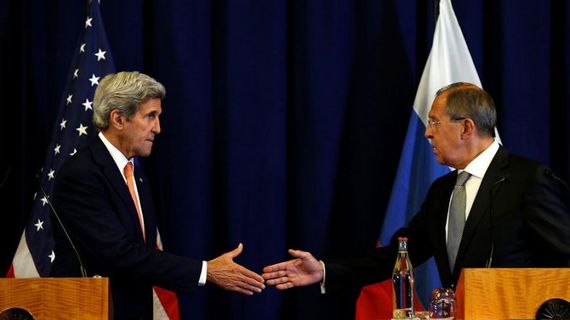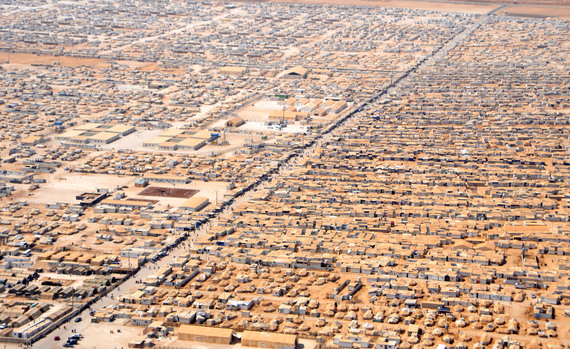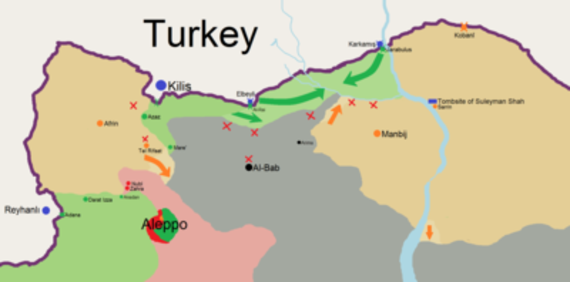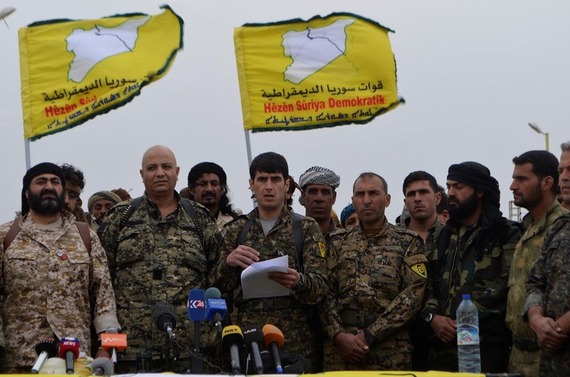US Secretary of State John Kerry and Russian Foreign Ministeer Sergey Lavrov announcing a new Syrian cease fire, Geneva, September 9, 2016 Phote courtesy US Dept. of State
On September 9, 2016, U.S. Secretary of State John Kerry and Russian Foreign Minister Sergey Lavrov announced that the United States and Russia had reached an agreement for a new 48-hour ceasefire in the Syrian Civil War.
Ostensibly, the purpose of the ceasefire is to enable aid convoys from Turkey to bring badly needed supplies to the besieged Syrian city of Aleppo. Some 250,000 people in rebel held areas of Aleppo have been cut off since July 2016.
The agreement is to be renewed every 48 hours, providing that it holds. After a week the U.S. and Russian air forces are supposed to expand their cooperation and stage joint air attacks against Islamic State and Jabhat Fateh al-Sham, formerly known as the al-Nusra Front. During this period the U.S. is responsible for identifying the locations of the U.S. backed "moderate rebel groups" and separating them from Jabhat Fateh al-Sham militants.
This was the second agreement brokered by the U.S. and Russia. An earlier agreement announced on February 22, 2016, proved short lived. It is unlikely that the second agreement will be any more successful. Syrian President Bashar al-Assad has already announced that "the Syrian state is determined to recapture every area from the terrorists."
Since it broke out in 2011, the Syrian Civil War has claimed approximately 500,000 lives, though no one is completely sure what the actual number is. An additional five million people, roughly one-quarter of Syria's prewar population, has been displaced and are now refugees. An additional 6.6 million have been internally displaced within Syria. Roughly one million refugees have requested political asylum in Europe.
While efforts to end the violence and find a political solution to Syria's Civil War is laudatory; this ceasefire will do neither. Instead it represents yet another strategic defeat for the United States, one more in what has been a long line of diplomatic defeats in Syria. In the meantime, the Obama administration has allowed both Russia and Turkey to manipulate U.S. policy for their own ends.
Syrian refugee camp in Zaatari Jordan
The U.S. intervention in the Syrian Civil War was prompted by the battlefield successes of the Islamic State (IS) and the rise of the al-Qaeda affiliated al-Nusra Front, as well as the emergence of other radical jihadist groups. American military intervention was part of a broad coalition of about a dozen countries, including some NATO members, Saudi Arabia and its Gulf allies, as well as Jordan and Turkey. Although the amount of air power unleashed was formidable, its effectiveness for the first two years of the campaign was constrained by rules of engagement so restrictive that only one out of four missions actually attacked its intended target.
While the White House declared on numerous occasions that Bashar al-Assad was an obstacle to a lasting peace on Syria, and even went so far as to declare that the Syrian government's use of chemical weapons would be a "red line" in Washington's relations with Damascus, the Obama administration made no serious effort to actually replace the Assad regime and conveniently forgot about its red line.
It was clear from the beginning of the American intervention, that while American and coalition air power could help to contain the further expansion of the Islamic State, it would ultimately take boots on the ground to actually roll back IS. Accordingly, the U.S. looked to recruit, train and arm so called "moderate rebel factions" as American proxies in the ground war. Washington spent billions of dollars in this effort only to eventually acknowledge that the program had largely failed.
Saudi Arabia and its Gulf allies spent even more in the same type of effort. Although their definition of "moderate" was more expansive than that of the United States, it included virtually everyone except for the al-Nusra Front and other extremist jihadist organizations, that effort also failed to create an anti-Assad force whose political and social agenda would have been acceptable to Western nations.
The Saudi's and the Turks were successful, however, in creating broad coalitions of various jihadist rebel groups in order to better coordinate the military effort against the Assad government; give the anti-Assad forces critical mass on the battlefield and facilitate the provision of supplies and financing. There have been various coalitions that have been created and which subsequently disintegrated. The two largest groups currently are the Turkish and Qatari sponsored Ahrar-al-Sham (Islamic Movement of the Free People of the Levant) and the Saudi sponsored Jaish al-Islam (Army of Islam). Ahrar al-Sham includes elements of the Free Syrian Army, the original group that launched the rebellion against the Assad government. It is the second largest rebel group in the Syrian war. Its strength is estimated at between 10,000 and 20,000 fighters. Various militant groups associated with Ahrar al-Sham participated in the Turkish led invasion of north Syria in August 2016.
That invasion was designed to clear out ISIS militants along the Turkish-Syrian border and more importantly, for Turkey, prevent the linkup of Syrian Kurdish forces west of the Euphrates River with those in Afrin canton further west. That linkup would have united the predominantly Kurdish areas in northern Syria. When the Turkish invasion began, Ankara demanded, and the U.S. acquiesced, that the American backed, Kurdish led, Syrian Democratic Forces (SDF) immediately withdraw east of the Euphrates or they would be attacked.
Disposition of forces in northern Syria as of mid-September 2016. Green is Turkish/Syrian rebel controlled zone, tan is Kurdish zone, red is Syrian government zone and black is Islamic State zone.
Russia, Syria and Egypt have designated Ahrar al-Sham as a terrorist organization. Surprisingly, according to a report in the Gulf News, the United Arab Emirates, a close Saudi ally, have also designated Ahrar al-Sham as a terrorist organization. The group's stated intention is the overthrow of the Assad government and the creation of an Islamic State under Sharia law.
Jaish al-Islam is the largest rebel group fighting in Syria. Its strength is estimated at between 20,000 and 25,000 militants. Unlike Ahrar-al Sham, Jaish al-Islam specifically rejects the participation of the Free Syrian Army. The group consists of about 50 different jihadist factions. There are an additional 150 to 200 other rebel groups that collaborate with Jaish al-Islam or which have, at different times, been affiliated with it. The group is largely funded by Saudi Arabia.
Training programs, under Pakistani Army officers, have also been underwritten by the Saudis. Russia, Syria and Egypt have designated Jaish al-Islam as a terrorist organization. Like Ahrar al-Sham, Jaish al-Islam is committed to the overthrow of the Assad regime and to the establishment of an Islamic state under Sharia law.
Neither the United States nor its European allies have formally designated either group as a terrorist organization. Both groups are predominantly Sunni Muslim-based, and both groups have denounced any kind of secular democratic government as un-Islamic and vowed to expel Shiite Muslims, including Syria's Alawite minority, from Syria.
In at least one instance, U.S. Secretary of State John Kerry verbally referred to both organizations as terrorist groups but a State Department spokesman later walked back his comments. Both the U.S. and various European governments have continued to try to engage both organizations and, in particular, to identify "moderate" elements within both organizations, which they could support.
The ceasefire agreement calls for the U.S. and Russia to establish "a joint integration center" in Geneva, possibly as early as September 19, where American and Russian military officials could decide on "shared targets" and "coordinated military strikes." The last time Americans and Russians had such discussions was when the Army Air Force based approximately 250 B-17 Flying Fortresses and B-25 Liberator bombers and their escort fighters in three Soviet airfields in the Ukraine during World War II.
As part of this "military cooperation," the U.S. is tasked with separating "moderate" elements within both Ahrar al-Sham and Jaish al-Islam from Jabhat Fateh al-Sham militants and other radical jihadists. Given the fluidity of these organizations base of support, how readily militants switch from one organization to another, and how frequently "opportunistic" battlefield alliances of convenience are formed by the different jihadist organizations, the U.S. has no effective means to identify, much less verify, who are the "good jihadists" and who are the "bad" ones.
Syrian Democratic Forces militia
Many of the so-called "moderate groups" that the U.S. is trying to support also cooperate with more radical jihadist organizations, including Jabhat Fateh al-Sham, and are also part of either Ahrar al-Sham or Jaish al-Islam. The risk for the United States, is that they will be blamed for Russian attacks against American sponsored rebel groups. As one unnamed U.S. official, quoted in a Reuters news dispatch, put it, "the Russians aren't using precision guided munitions in Syria, which gives them a perfect excuse to say, sorry, we weren't aiming for your guys."
When the Kremlin intervened in the Syrian Civil War, its principal aim was to shore up the Assad regime and to transform the "political reality" in Syria by making the government of Bashar al-Assad the only realistic alternative that the U.S. and its European allies could support. It has largely accomplished this
Although the U.S. has stopped short of declaring its support for the continuation of the Assad government, by allowing its proxies on the ground, the Kurdish led SDF in north Syria and the so-called "moderate groups," to be attacked and marginalized, it has effectively accepted Bashar al-Assad as the best of the worst alternatives.
More significantly, the steady Islamization and radicalization of the rebel groups means that even if the U.S. succeeds in rolling back the Islamic State, the civil war in Syria will simply continue as a conflict between the un-democratic, but secular, Russian and Iranian supported, Assad government, and one or more rebel alliances, supported by Turkey and Saudi Arabia, committed to the establishment of a theocratic Islamic state under Sharia law.
Should the rebels prevail, it's possible that there will be an additional civil war between the various Sunni groups to determine who will dominate the new Islamic state, or its equally possible that the other groups will coalesce around one of the larger jihadist factions. If that group turns out to be al-Qaeda inspired, Jabhat Fateh al-Sham, then the U.S. led effort in Syria will have accomplished little more than replacing the original Islamic State with a far larger, al-Qaeda linked version. The most likely scenario is a combination of the two possible outcomes: some fighting among the Sunni rebel groups while others coalesce around the strongest of those groups.
Jabhat Fateh al-Sham, formerly al-Nusra Front, fighters in Syria
This is a no-win situation for the United States. Either it accepts the continuation of a pro-Russian and pro-Iranian regime, one that will expand Moscow's and Tehran's influence in the region and further strengthen the Iranian led, "Shiite arc of influence" and pit Washington against its traditional Turkish and Saudi allies, or it will find that it has conducted its military effort to destroy the Islamic State just to pave the way for the creation of another, potentially equally dangerous, Sharia-based Islamic state.
It is not a foregone conclusion that such a state would be anti-Western in its orientation. It depends on which of the rebel groups ultimately ends up controlling the new government. It certainly won't be pro-Western. At best, it might prove to be neutral or ideologically anti-Western, but not violently so. The odds, however, make it more likely that it will be militantly anti-Western than not.
The legacy of five years of the Obama administration's Syrian policy is that it has severely damaged American credibility in the region. The willingness with which it has abandoned its proxies in the Syrian ground war will not be easily forgotten neither will the complete ineffectiveness of its foreign policy in Syria.
The United States remains the world's only superpower. In the Syrian Civil War, however, the White House has allowed Russia and Turkey to manipulate it for their own ends, and in the process financed a war whose ultimate outcomes are all likely to prove equally disagreeable for American interests. It has allowed the Kremlin to largely set the agenda for Russian-American engagement in the Syrian war, and it has consistently failed to set out a coherent strategy for how to deal with the violence in Syria.
The United States may ultimately succeed in defeating the Islamic State. What will follow, however, will likely be just as inimical to America's long-term interests in the region. This is not how a great power is supposed to behave or conduct its foreign policy. That lesson will not be lost on either America's friends or its ever growing list of enemies in the Middle East.





